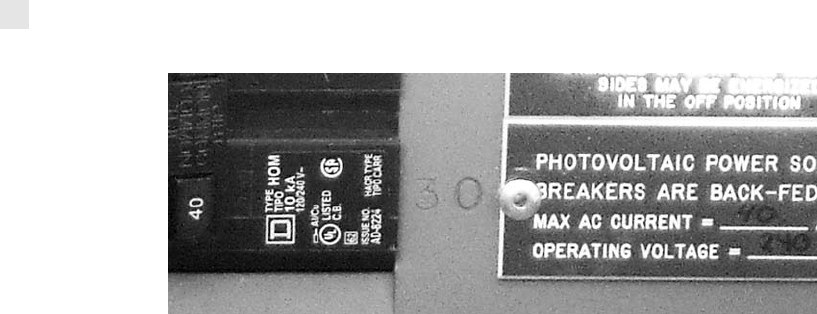
NEC Article 690 specifically deals with PV systems. There are other sections
of the Code that contain information about PV systems [90.2, 720]. When there is
a conflict between Article 690 of the NEC and any other article, Article 690 takes
precedence [690.3].
Testing and Approval
The Code suggests that equipment be approved by a testing laboratory. Equip-
ment used in PV systems should be identified, listed, labeled, or tested [90.7, 100,
and 110.3]. There are two established national testing organizations—
Underwriters Laboratories (UL) and ETL Testing Laboratories, Inc. (ETL).
The NEC suggests that PV installers use listed devices. A listed device is
tested against the testing laboratory standards. A recognized device is tested to
standards created by the device manufacturer. Very few inspectors accept prod-
ucts that are merely “recognized” rather than “listed,” with the exception of over-
current protection products. Some recognized components are used within a
factory-assembled product. That complete product becomes listed as a piece of
equipment.
Building and electrical inspectors expect to see labels (UL, ETL) on electrical
products used in PV system installations. They rely on UL and ETL listed mecha-
nisms. This distresses many in the PV industry, who know
that the labels inspectors look for come only after a lot of
expensive testing. Makers of traditional electrical products
can spread the cost of such testing over large production runs.
This is not so for PV manufacturers, whose products are gen-
erally made in much smaller batches. For them the laboratory
label is a seal of approval they can ill afford.
Marking and Labeling PV Systems in Relation to
Regulation and Code
Marking is essential on all PV equipment. It provides warning and guidance.
Marking identifies energized electrical lines. Marking alerts the fire service to
avoid cutting live DC circuits. DC circuits may be live even when the grid is down.
Most PV installers use preprinted metal labels to mark PV equipment. Preprinted
metal labels will not fade or fall off once attached.
The NEC requires labeling, which identifies PV system components with
permanent markings, such as wire tabs or numbering. The Code requires very
specific information on PV equipment and component labels. It also helps to
have drawings and photos to identify all equipment with its corresponding loca-
tion. Diagrams help ensure that everything is labeled. PV workers will know the
location of every component along with its voltage, current, and AC and
DC issues.
NOTE
PV system electrical components are
not manufactured in the same large
quantities as components of traditional
power systems.
CHAPTER 5
Building Codes and Regulations for PV Systems 99

Identify all source circuits with permanent markings such as wire tabs.
Alternatively, use a numbering method. Some systems are quite complex. Label all
the points of connection as they relate to points on the PV system drawings. This
makes system checkout and maintenance easier. The label should include the fol-
lowing information supplied by the manufacturer, including:
Polarity of output terminals or leads
Maximum series fuse for module protection
Open-circuit voltage rates
Operating voltage rates
Operating current rates
Short-circuit current rates
Maximum power
Maximum permissible system voltage (NEC 2011, Article 690.51)
The maximum permissible system voltage is calculated by multiplying the
value of Voc on the listing label by the appropriate value on Table 690.7 in the
NEC, which is then multiplied by the number of modules in a series string.
The local AHJ and utility have the final say in all installations. Occasionally,
installations are completely code-compliant but do not pass the utility inspection.
The utility company’s inspection is required for interconnection to the grid. It
may have additional interconnection standards. These additional standards are
required prior to commissioning. For example, the Code does not require that
grid-tied PV systems have a lockable disconnect at the utility access point. This
may be a local utility requirement.
This is an example of a label showing maximum AC current and operating voltage.
Courtesy of PerfectPower, Inc.
100 ADVANCED PHOTOVOLTAIC INSTALLATIONS

PV systems with battery backups have to be inspected by
the local fire inspector. NEC 2011, Article 702.8, states that “a
sign shall be placed at the service-entrance equipment that
indicates the type and location of on-site optional standby
power sources.”
Refer to the PV System Installation Checklist found in
Chapter 1 for ensuring that all installation components are marked and labeled.
Its importance cannot be stressed enough.
NOTE
Have PPE (hardhat, gloves, and eye
protection) on hand prior to PV system
testing.
CHAPTER 5
Building Codes and Regulations for PV Systems 101

Listed device
Maximum permissible system voltage
Recognized device
Chapter 5 Summary
This chapter focuses on OSHA and NEC requirements for PV safety. Following these
regulations and codes is critical to the safety of PV system installation. It reduces and elimi-
nates job-related injuries, hazards, or death. Use safety tips and recommendations when
working with PV systems. Make sure you use marking and labeling to help identify different
components of PV systems, including live electrical circuits. Following these practices will
ensure safety. It also will reduce the amount of time and money you will spend on having to
redo non-compliant installations.
Key ConCeptS and termS
Chapter 5 aSSeSSment
Building Codes and Regulations for PV Systems
1. OSHA rules for personal protection and life-saving equipment are found in OSHA Part 1926
Subpart E.
A. True
B. False
2. A fall protection system must be in place for all work done at heights in excess of:
A. 4 feet.
B. 8 feet.
C. 10 feet.
D. 6 feet.
3. What mA electrical currents can paralyze muscles and cause a worker to fall when working
at heights?
A. 10
B. 30
C. 50
D. 75
4. What mA electrical currents can cause a rapid, irregular heartbeat and lead to death in a
few minutes?
A. 10
B. 30
C. 50
D. 75
102
ADVANCED PHOTOVOLTAIC INSTALLATIONS

5. OSHA requires that fall protection be used for walkways and ramps, holes and excavations,
roofs, and wall openings where an employee or worker can fall _______ feet or more.
A. 4
B. 6
C. 8
D. 10
6. What class of hardhat offers the maximum head protection from impacts and electrical
shock?
A. Class A
B. Class III
C. Class B
D. Class C
7. What PPE would be most important when operating a power drill?
A. Ear plugs
B. Gloves
C. Goggles
D. Shoes
8. What is the name of an established national testing organization?
A. Underwriters Laboratories
B. Dexter’s Laboratory
C. ETL Testing Laboratories
D. A and C
9. The severity of electrical shock depends on what? (Choose any and all that apply.)
A. Duration
B. Path
C. Amount of current
D. Temperature in workplace
10. OSHA requires that a stairway or ladder be used at points of access where there is an
elevation break of _______ inches or more on a job site.
A. 13
B. 16
C. 19
D. 21
CHAPTER 5 Building Codes and Regulations for PV Systems 103
..................Content has been hidden....................
You can't read the all page of ebook, please click here login for view all page.
